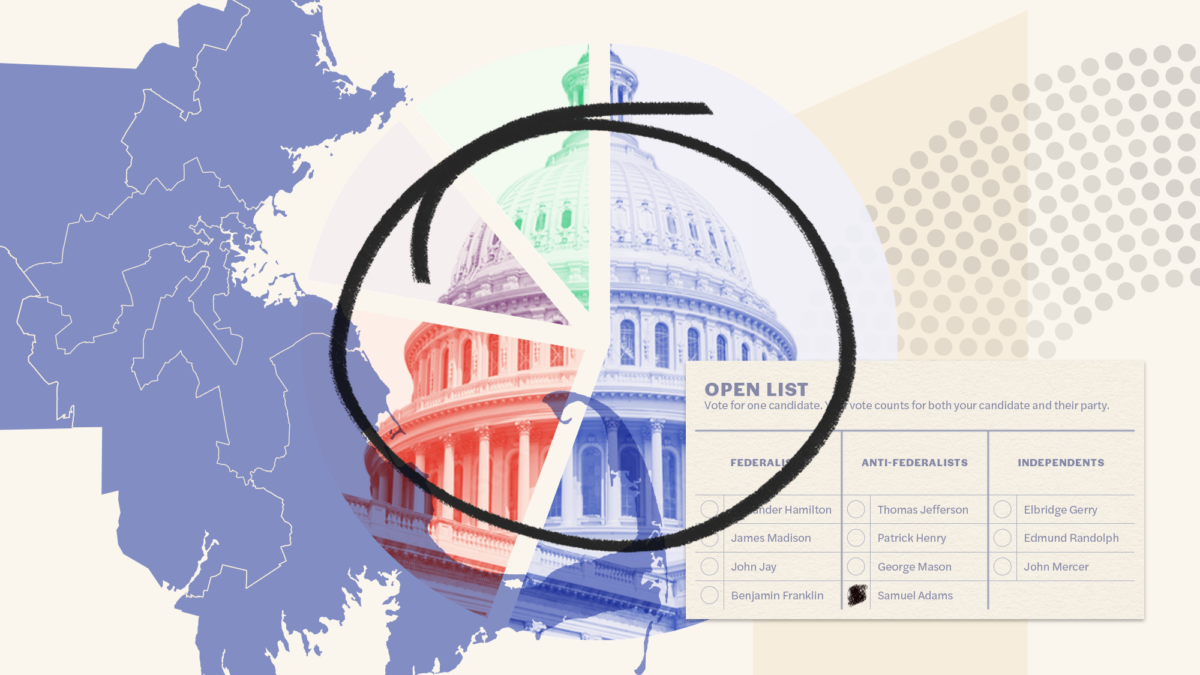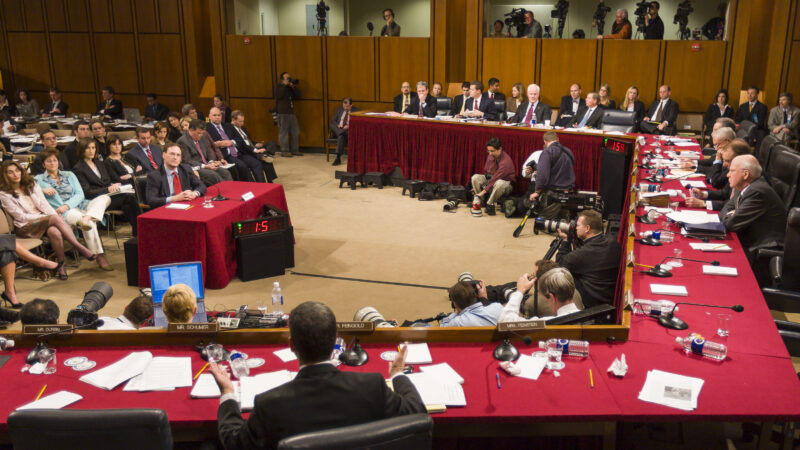Multipartyism in Congress
- September 12, 2023

Never high to begin with, Americans’ faith in Congress is at an all-time low. So how do we make things better? An increasingly popular solution is to replace our two-party system with multiple parties and proportional representation. The thinking goes that what the electorate needs is more, and presumably better, choices that reflect our varied ideological orientations and assorted political priorities. Instead of narrowing the field to Republicans and Democrats, we should let our party garden bloom, with Greens and Socialists putting down roots on the left and nativists and Christian fundamentalists splitting off from the GOP to form their own parties on the right. And once freed from the rigidity of a two-party system where gridlock is preferable to giving the other side a win, members of Congress could more easily form issue-specific coalitions to address the country’s most pressing problems.
These are laudable goals. But as we move from theory to institutional reality, some caution is in order. In our view, grafting a multiparty system with proportional representation onto existing constitutional and legislative arrangements risks exacerbating longstanding congressional pathologies. At a minimum, reformers may want to consider the possibility that the new order would compound Congress’s already serious collective action problems and thereby further distort our off-kilter separation of powers system.
This isn’t just knee-jerk skepticism of change. Rarely over the course of congressional history have reformers succeeded in razing existing arrangements to build new ones on a clean foundation. Rather, because reforms are inevitably layered atop older rules and procedures, the institutional practices that emerge are often internally inconsistent and inefficient. Reforms may even provoke contradictory counter-reforms that further gum up the works. This is exactly what happened to reformers in the 1970s when they tried to streamline Congress’s baroque budget process. Unable to revoke the rights of existing committees to authorize spending, they created a new budget committee to set spending priorities but gave it little capacity to control the choices of authorizing committees. The result was an even more convoluted process than they’d started with, requiring the new budget committee to work with all of the other committees to craft fiscal policy. For these reasons, we think it best not to assume that imposing a system of multiple parties with proportional representation would necessarily (or even likely) be accompanied by other changes designed to smooth the transition from our current system or to maximize the reform’s potential upside.
In thinking through these institutional challenges, we focus our attention on the House of Representatives — motivated, among other things, by the practical consideration that the Senate’s allocation of two seats per state makes it difficult if not impossible to implement a more proportional system of representation without also altering fundamental features of the upper chamber.
Who runs the house?
At the beginning of every Congress, the House selects a speaker — an office empowered by the Constitution and the rules of the chamber to dictate the pace and scope of lawmaking. While the choice is often a fait accompli, Representative Kevin McCarthy’s turbulent ascent to the position in early January 2023 makes clear that finding a consensus candidate is not always easy, even when one party controls an outright majority. Were multiple parties to win congressional seats, selecting a speaker might become even more fraught. Unless one party could claim 218 votes on its own, at least two parties would have to agree on a candidate. No legislative business could be conducted until a deal was struck. And given the possibility of multiple alliances, there is reason to worry about the durability of any deal. Should the coalition backing the speaker fracture and a different coalition arise in its place, lawmakers would be back at square one.
In other countries, challenges like these are often smoothed over with the spoils of government. For example, potential coalition partners might be promised ministerial positions in exchange for their agreement to vote as part of a majority bloc. But Congress, as is true of other legislatures in presidential systems across the world, has limited capacity to distribute such spoils on its own. Here, it is the President’s constitutional prerogative to make Cabinet nominations, and the President who oversees the day-to-day work of federal agencies.
So, what’s an aspiring coalition leader in the House to do? One possibility is to partner with the President. By working directly with the executive or at her behest, a would-be speaker would have access to a broad array of spoils to distribute, from formal Cabinet and ambassadorial appointments to discretionary programs that could be targeted to a coalition partner’s favorite constituency. But, if the experience of countries like Brazil with a multiparty presidential system is any indication, chances are good that we would be trading legislative independence for coalitional expediency. Assembling a majority coalition might well be easier with the benefit of a President’s largesse. But the key choices that are currently the prerogative of the speaker — most importantly, which issues to prioritize and when — would effectively be the President’s to decide. To the extent that we are already worried that presidents are encroaching on Congress’s turf, multipartyism may accelerate the trend.
So, could Congress go it alone? What resources do lawmakers have at their unique disposal to facilitate the formation of a majority coalition? Two come to mind. Under current House rules, the majority party has the nearly exclusive right to determine what pieces of legislation are ultimately considered by the chamber. And so, in exchange for helping to secure a majority, a leader might promise potential coalition partners priority of place on the legislative agenda. Alternatively, would-be speakers might seek to monetize the committee system, promising potential coalition partners seats on the House’s most powerful committees — Appropriations, for example, or Ways and Means — in return for their support.
But these legislative spoils may not be sufficient to stitch coalitions together. Promises of space on the agenda or plum committee posts are just that — promises. As studies of comparative politics make clear, meaningful enforcement mechanisms are critical to the success or failure of legislative coalitions. Yet, the contemporary House lacks such mechanisms. Because the speaker has so much discretion to set the agenda and allocate committee seats within the majority, coalition partners will have little recourse short of dissolving the coalition to make sure she holds up her end of the bargain. Absent such assurances, potential coalition partners may be reluctant to commit their votes to the collective cause in the first place. To be sure, limiting leaders’ discretion may make coalition partners more confident in their capacity to hold leaders to the bargains they’ve struck. But weakening leadership in this way also risks undercutting the coalition’s capacity to craft durable alliances in the first place.
This is not to suggest that congressional leaders today are saved the work of negotiating with members of their own party. After all, in our current institutional environment, a successful bid for the speakership often requires candidates to make concessions to key stakeholders. Think here of former Speaker Nancy Pelosi’s 2018 effort to win over the Congressional Progressive Caucus by offering the group a greater say in party affairs. But striking a deal was made easier by the fact that House progressives’ fate was linked to Pelosi’s success. As Democrats, they would all run in subsequent elections under the same party label and tout the same legislative record. They were also accountable to overlapping groups of voters, donors, and activists — all socialized to think of themselves as players on the Democratic team.
Without the benefit of a shared party affiliation, the task of putting together a majority coalition necessarily becomes both more difficult and more time-consuming. Time, however, is not something legislators can afford to spend more of. Our legislative process is already cumbersome and rife with veto points. Our two-party system is far from perfect, but at least it spares us the need to decide who’s in the majority.
Who runs committees?
Although House committees today are not as important as they once were, it is still true that most bills are drafted, discussed, and amended in committee. Given committees’ centrality to the legislative process, majority parties have consistently sought to maintain at least a slim majority on every committee. With only two congressional parties, this has generally involved relatively straightforward negotiations between leaders on both sides over the ratio of majority to minority party members on each committee. Historically, these ratios have tended to reflect the majority’s relative size. The more seats it commands, the more every committee is stacked in its favor.
But if multiple parties were represented in the House, dividing up committee seats among the various party claimants might pose hard questions for the governing coalition. Would seats be allocated on every committee in proportion to each party’s overall numerical strength? Doing so would make the math easy and be consistent with existing practice. But, assuming all significant committee decision-making remained subject to a simple majority vote, distributing seats on a proportional basis would routinely put the governing coalition’s discipline to the test. Every committee decision, no matter how small, would demand that members representing the governing coalition act as one, challenging them to put aside their differences and work collectively on a near-daily basis and with little room for error. Put differently, committees might transform into vulnerable pressure points, inviting the opposition to probe the governing coalition’s weaknesses.
Alternatively, seat allocations could take into account the policy priorities of each party within the coalition. Stacking, say, the Energy and Commerce Committee with members of the Green Party might yield better policy. After all, we tend to think that lawmakers invested in a topic or problem will take the time to become expert in it. But accommodating coalition partners’ policy priorities in this way risks turning individual committees into ideological outliers relative to the governing coalition as a whole — already a concern in our present system. This may jeopardize the chances that bills that win majority support in committee will also pass on the House floor.
A governing coalition could decide to sidestep these questions by deemphasizing committees as the primary locus of legislative activity, turning instead to House leaders to coordinate chamber business. Current legislative practice offers precedent for such a move. In recent decades, members’ frustration with the slow pace of committee work has prompted them to cede greater legislative-drafting authority to leaders to hasten consideration of bills on the floor, in the process overriding committee prerogatives. But with multiple parties and proportional representation, coalition partners may not wish to empower their leadership in this way, fearing that a broad delegation of power could be used to advance the policy priorities of the leader’s own party (or the President) and not those of the collective.
Who runs the government?
Observers of American politics have long worried that Congress — like its cousins in other presidential democracies — is ill equipped to restrain an increasingly “imperial” President. The executive, they note, is a single actor with a vast and hierarchically organized bureaucracy at her command. Congress, in contrast, is a collective body. To do anything, lawmakers must run the legislative gauntlet — from drafting to committee markup, floor referral, and conference-committee harmonization. So while the executive and legislative branches were designed to be coequal, in practice, they are not.
Introducing multiple parties and proportional representation risks making a bad situation worse. However difficult it is for lawmakers to act collectively today — and we think there is strong evidence that it is quite difficult — doing so in a system with multiple parties and proportional representation is, at minimum, unlikely to be any easier. Proponents of the reform imagine that carving up our big-tent parties will encourage smaller groupings of lawmakers to work together across the ideological spectrum on those areas where their policy priorities ostensibly align (or at least overlap). But research on congressional polarization and party branding should make us skeptical that, in a multiparty system, parties would not be every bit as eager as they are now to seize on opportunities to “message” their differences and, in so doing, distinguish themselves from the competition. To the extent that parties are in it for themselves — that is, that lawmakers are interested in the fate of their party team and not just the ideas it promotes — we should not expect a multiparty Congress to be any better at resolving its collective action and coordination dilemmas. Indeed, it may be worse.
The consequences could be deleterious for both domestic and foreign policy. At home, Congress’s inability to act collectively risks prompting the President to bypass the legislature and work through the bureaucracy to realize her policy program. While recourse to the administrative state is often not as durable as legislation, consistent reliance on the bureaucracy fosters the expectation that the President will — and perhaps should — act unilaterally whenever a new challenge arises. Abroad, these dynamics may well further liberate the executive to conduct the nation’s foreign policy with even less input or oversight from lawmakers than we have today.
There is also the danger that in a House with multiple parties and proportional representation, lawmakers might well prefer to let the President call more of the shots. When reaching agreement in Congress proves difficult, one solution is to rely on the President to grease the skids, be it through patronage or other sweeteners (e.g., fundraising assistance, targeted agency policymaking), as is common in many contemporary multiparty presidential systems. Another is to let some other actor — often bureaucrats, but sometimes courts — hammer out the details. This isn’t all that unusual in our own history. In writing the Clean Air Act, for example, legislators opted not to fight about fuel efficiency standards, instead leaving the choice to the EPA. It is conceivable that delegations of this kind would be even more appealing for a governing coalition composed of multiple parties, where disagreements are likely to be more frequent (if not more intractable). And if that’s true, we run the risk that Congress will give away much of the power it has managed to retain.
No party system is perfect. But to the extent that ours has evolved to cope with the challenges of two-party duopoly, a switch to multiple parties and proportional representation may be more trouble than it’s worth.
This piece originally appeared in For A Better Democracy: Proportional Representation, a symposium published by Democracy Journal in partnership with Protect Democracy and with support from Democracy Fund.
Related Content
Join Us.
Building a stronger, more resilient democracy is possible, but we can’t do it alone. Become part of the fight today.
Donate
Sign Up for Updates Sign Up for Updates
Explore Careers Explore Careers
How to Protect Democracy How to Protect Democracy



